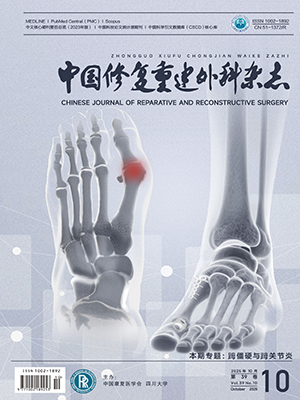Objective To investigate the application potential of alginate-strontium (Sr) hydrogel as an injectable scaffold material in bone tissue engineering. Methods The alginate-Sr/-calcium (Ca) hydrogel beads were fabricated by adding 2.0wt% alginate sodium to 0.2 mol/L SrCl2/CaCl2 solution dropwise. Microstructure, modulus of compression, swelling rate, and degradability of alginate-Sr/-Ca hydrogels were tested. Bone marrow mesenchymal stem cells (BMSCs) were isolated from femoral bones of rabbits by flushing of marrow cavity. BMSCs at passage 5 were seeded onto the alginate-Sr hydrogel (experimental group) and alginate-Ca hydrogel (control group), and the viability and proliferation of BMSCs in 2 alginate hydrogels were assessed. The osteogenic differentiation of cells embeded in 2 alginate hydrogels was evaluated by alkaline phosphate (ALP) activity, osteoblast specific gene [Osterix (OSX), collagen type I, and Runx2] expression level and calcium deposition by fluorescent quantitative RT-PCR and alizarin red staining, Von Kossa staining. The BMSCs which were embeded in alginate-Ca hydrogel and cultured with common growth medium were harvested as blank control group. Results The micromorphology of alginate-Sr hydrogel was similar to that of the alginate-Ca hydrogel, with homogeneous pore structure; the modulus of compression of alginate-Sr hydrogel and alginate-Ca hydrogel was (186.53 ± 8.37) and (152.14 ± 7.45) kPa respectively, showing significant difference (t=6.853, P=0.002); there was no significant difference (t=0.737, P=0.502) in swelling rate between alginate-Sr hydrogel (14.32% ± 1.53%) and alginate-Ca hydrogel (15.25% ± 1.64%). The degradabilities of 2 alginate hydrogels were good; the degradation rate of alginate-Sr hydrogel was significantly lower than that of alginate-Ca hydrogel on the 20th, 25th, and 30th days (P lt; 0.05). At 1-4 days, the morphology of cells on 2 alginate hydrogels was spherical and then the shape was spindle or stellate. When three-dimensional cultured for 21 days, the DNA content of BMSCs in experimental group [(4.38 ± 0.24) g] was significantly higher than that in control group [(3.25 ± 0.21) g ] (t=8.108, P=0.001). On the 12th day after osteogenic differentiation, the ALP activity in experimental group was (15.28 ± 1.26) U/L, which was significantly higher than that in control group [(12.07 ± 1.12) U/L] (P lt; 0.05). Likewise, the mRNA expressions of OSX, collagen type I, and Runx2 in experimental group were significantly higher than those in control group (P lt; 0.05). On the 21th day after osteogenic differentiation, alizarin red staining and Von Kossa staining showed calcium deposition in 2 groups; the calcium nodules and phosphate deposition in experimental group were significantly higher than those in control group (P lt; 0.05). Conclusion Alginate-Sr hydrogel has good physicochemical properties and can promote the proliferation and osteogenic differentiation of BMSCs, so it is an excellent injectable scaffold material for bone tissue engineering.
Citation: TU Yiji,WU Tianlong,YE Aifang,XU Junhuai,GUO Fei,CHENG Xigao. IN VITRO STUDY ON INJECTABLE ALGINATE-STRONTIUM HYDROGEL FOR BONE TISSUE ENGINEERING. Chinese Journal of Reparative and Reconstructive Surgery, 2013, 27(12): 1499-1505. doi: 10.7507/1002-1892.20130329 Copy
Copyright © the editorial department of Chinese Journal of Reparative and Reconstructive Surgery of West China Medical Publisher. All rights reserved
-
Previous Article
EXPERIMENT OF BONE MORPHOGENETIC PROTEIN 2 INDUCED CHONDROGENIC DIFFERENTIATION OF HUMAN Achilles TENDON-DERIVED STEM CELLS IN VITRO -
Next Article
EXPERIMENTAL STUDY OF DIFFERENTIATION OF UMBILICAL CORD MESENCHYMAL STEM CELLS INTO SMOOTH MUSCLE CELLS INDUCED BY BLADDER SMOOTH MUSCLE CELLS CONDITIONED MEDIUM




